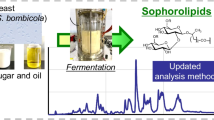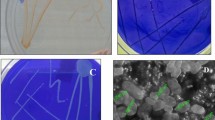Abstract
Pseudomonas aeruginosa LBI isolated from petroleum-contaminated soil produced rhamnolipids (RLLBI) when cultivated on soapstock as the sole carbon source. HPLC–MS analysis of the purified culture supernatant identified 6 RL homologues (%): R2 C10 C10 28.9; R2 C10 C12:1 23.0; R1 C10 C10 23.4; R2 C10 C12 11.3; R2 C10 C12 7.9; R2 C10 C12 5.5. To assess the potential antimicrobial activity of the new rhamnolipid product, RLLBI, its physicochemical properties were studied. RLLBI had a surface tension of 24 mN m−1 and an interfacial tension of 1.31 mN m−1; the cmc was 120 mg l−1. RLLBI produced stable emulsions with hydrocarbons and vegetable oils. This product showed good antimicrobial behaviour against bacteria: MIC for Bacillus subtilis, Staphylococcus aureus and Proteus vulgaris was 8 mg l−1, for Streptococcus faecalis 4 mg l−1, and for Pseudomonas aeruginosa 32 mg l−1. RLLBI was active against phytopathogenic fungal species, MIC values of 32 mg l−1 being found against Penicillium, Alternaria, Gliocadium virens and Chaetonium globosum. Due to its physicochemical properties and antimicrobial behaviour, RLLBI could be used in bioremediation treatment and in the food, cosmetic and pharmaceutical industries.
Similar content being viewed by others
References
Abalos A., Pinazo A., Infante R., Casals M., García F. and Manresa A. 2001. Physico chemical and antimicrobial properties of new rhamnolipids produced by Pseudomonas aeruginosa AT10 from soybean oil refinery wastes. Langmuir 17: 1367-1371.
Attwood D. and Florence A. 1983. Emulsions in Surfactants Synthesis, Chemistry, Pharmacy and Biology. Chapman and Hall, New York, pp. 469-566.
Banat I., Makkar R. and Cameotra S. 2000. Potential commercial applications of microbial surfactants. Appl. Microbiol. and Biotechnol. 53: 495-508.
Benincasa M., Abalos A., Moreira I. and Manresa A. 2002. Rhamnolipid production by Pseudomonas aeruginosa LBI growing on soapstock as the sole carbon source. J. Food Eng. 54: 283-288.
Chandrasekaran E.V. and Bemiller J.N. 1980. Constituent analysis of glucosamonoglucans. In: Wrhiste L. and Wolfrom M.L. (eds), Methods in Carbohydrate Chemistry Vol. iii. Academic Press, New York, pp. 89-97.
Desai J. and Banat I. 1997. Microbial production of surfactants and their commercial potential. Microbiol. Mol. Biol. 61: 47-64.
Déziel E., Lépine F., Dennie D., Boismenu D., Mamer O. and Villemur R. 1999. Liquid chromatography/mass spectrometry analysis of mixture of rhamnolipids produced by Pseudomonas aeruginosa strain 57RP grown on mannitol or napthalene. Biochim. Biophys. Acta 1440: 244-252.
Espinel-Ingroff A. and Pfaller M.A. 1995. Antifungal agents and susceptibility testing. In: Murray P.R. (ed.), Manual of Clinical Microbiology, Cap X. Murray, PR, Washington, DC, pp. 1405-1415.
Folch J., Lees M. and Sloane S.G. 1957. A simple method for the isolation and purification of total lipids from animal tissues. J. Biol. Chem. 226: 497-509.
Gerardin-Charbonier C.A., Molina S., Achilefeu L., Manresa A., Vinardell P. and Selve C. 1999. Preparation and antibiotic activity of monobactam analogues of nocardicins. Prep. Biochem. and Biotechnol. 29: 257-272.
Guerra-Santos L., Kappeli O. and Fiechter A. 1984. Pseudomonas aeruginosa Biosurfactant production in continuous culture with glucose as carbon source. Appl. Environ. Microbiol. 48: 301-305.
Haba E., Pinazo A., Jauregui O., Espuny M.J., Infante M.R. and Manresa A. 2003. Physico-chemical characterization and antimicrobial properties of the rhamnolipids products by Pseudomonas aeruginosa 47T2 NCIMB 40044. J. Surfactants Deterg. 6: 155-161.
Itoh S., Honda H., Tomita F. and Suzuki T. 1971. Rhamnolipids produced by Pseudomonas aeruginosa grown on n-paraffin. J. Antibiotics 24: 855-859.
Kitamoto D., Yanagishita H., Shinbo T., Nakane T., Kamisawa C. and Nakahara T. 1993. Surface active properties antimicrobial activities of mannosylerythritol lipids as biosurfactants produced by Candida antarctica. J. Biotechnol. 29: 91-96.
Lang S. and Wagner F. 1993. Biological activities and applications. In: Kosaric N. (ed.), Biosurfactant Properties and Applications Vol. 48. Marcel Dekker, New York, pp. 251-269.
Lang S. and Wullbrandt D. 1999. Rhamnose lipids biosynthesis, microbial production and application potential. Appl. Microbiol. Biotechnol. 51: 22-32.
Lin S.C. 1996. Biosurfactants: Recent advances. J. Chem. Tech. Biotechnol. 66: 109-120.
Lowry O.H., Rosebrought N.J., Farr A. and Randall R.J. 1951. Protein measurement with the Folin phenol reagent. J. Biol. Chem. 139: 265-274.
Maier R. and Soberon-Chavez G. 2000. Pseudomonas aeruginosa rhamnolipids: biosynthesis and potential applications. Appl. Microbiol. Biotechnol. 54: 625-633.
Mata-Sandoval J., Karns J. and Torrents A. 1999. High-performance liquid chromatography method for the characterization of rhamnolipids mixture produced by Pseudomonas aeruginosa UG2 on corn oil. J. Chromatogr. 864: 211-220.
Rosen M. 1978. Surfactants and Interfacial Phenomena. Wiley and Sons. Pub. Wiley Interscience, New York, pp. 149-159.
Rosenberg E. 1985. Microbial surfactants. Critical Rew. Biotechnol. 3: 109-132.
Sim L., Ward O. and Li Z.Y. 1997. Production and characterisation of a biosurfactant isolated from Pseudomonas aeruginosa UW-1. J. Indus. Microbiol. Biotechnol. 19: 232-238.
Syldatk C., Lang S. and Wagner F. 1985. Chemical and physical characterization of four interfacial-active rhamnolipids from Pseudomonas sp DSM 2874 grown on alkanes. Z. Naturforsch. 40c: 51-60.
Tiehm A. 1994. Degradation of polycyclic aromatic hydrocarbons in the presence of synthetic surfactants. Appl. Environ. Microbiol. 60: 258-263.
Vollbrecht E., Rau U. and Lang S. 1999. Microbial conversion of vegetable oils into surface-active di-, tri-, and tetrasaccharide lipids (biosurfactants) by the bacterial strain Tsukamurella spec. Fett. Lipid. 101: 389-394.
Woods G.L. and Washington J.A. 1995. Antibacterial susceptibility test: dilution and disk diffusion methods. In: Murray P.R. (ed.), Manual of Clinical Microbiology. Chap. X, Washington, DC, pp. 1327-1341.
Zhang Y. and Miller R. 1992. Enhanced octadecane dispersion and biodegradation by a Pseudomonas rhamnolipid surfactant (biosurfactant). Appl. Environ. Microbiol. 60: 2101-2106.
Author information
Authors and Affiliations
Rights and permissions
About this article
Cite this article
Benincasa, M., Abalos, A., Oliveira, I. et al. Chemical structure, surface properties and biological activities of the biosurfactant produced by Pseudomonas aeruginosa LBI from soapstock. Antonie Van Leeuwenhoek 85, 1–8 (2004). https://doi.org/10.1023/B:ANTO.0000020148.45523.41
Issue Date:
DOI: https://doi.org/10.1023/B:ANTO.0000020148.45523.41




